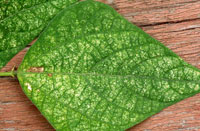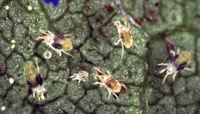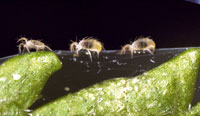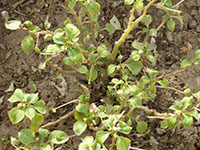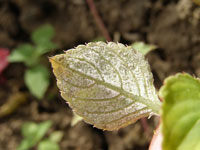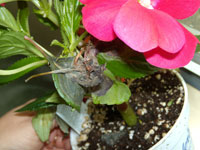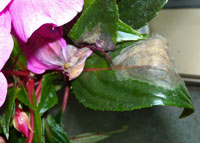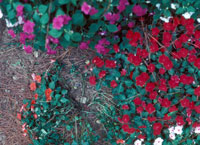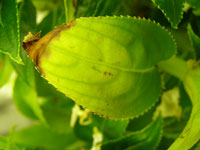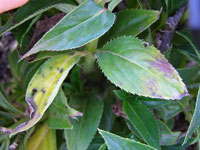Extension > Garden > Diagnose a problem > What's wrong with my plant? > Annuals and Perennials > Impatiens > Discolored leaves
Impatiens > Leaves > Discolored leaves
1 of 5
Two-spotted Spider Mite
Tetranychus urticae
- Active during summer, particularly abundant during hot, dry weather
- Pale spots or stippling appears on the upper leaf surface
- Leaves are discolored off green to whitish, yellowish, or bronze
- Premature leaf drop can occur
- Visible webbing occurs on infected leaves when populations are high
- Adults are tiny (1/50th inch long) and oval, greenish or yellowish with a dark spot on either side of the body
- More information on Two-Spotted Spider Mites (86 K PDF)
2 of 5
Downy Mildew
Plasmopara obducens
- Leaves turn pale green to yellow and may curl slightly downward downy white to fungal growth on underside of leaves
- Plants become yellow in color and stunted
- Infected leaves prematurely drop from the plant leaving a barren stalk with few leaves
- Disease favors cool, wet weather
- More information on Downy Mildew
3 of 5
Gray Mold
Botrytis cinerea
- Brown spots on leaves with concentric brown rings like a bull’s eye
- Brown blossoms or petals; flowers drop off prematurely
- Gray fuzzy mold develops on rotted tissue under humid conditions
- Disease develops during cool, wet weather
- More information on Gray Mold
4 of 5
Root Rot
Pythium spp., Rhizoctonia solani
- Leaves turn yellow and wilt
- Plants are stunted
- With Rhizoctonia sp., the base of the stem may turn brown and crack
- Roots have brown sunken areas and lack root hairs
- The outer root tissue is easily removed leaving behind thin, stringy root cores.
- Disease favors cool, wet soil with poor drainage
- Lab test necessary to distinguish between Rhizoctonia and Pythium Root Rot
- More information on Rhizoctonia root rot
- More information on Pythium root rot
5 of 5
Sunscald
- Exposed parts of leaves bleach yellow to white
- In severe cases, affected areas turn brown and brittle
- Symptoms more severe in dry hot weather
- More information on Sunscald



